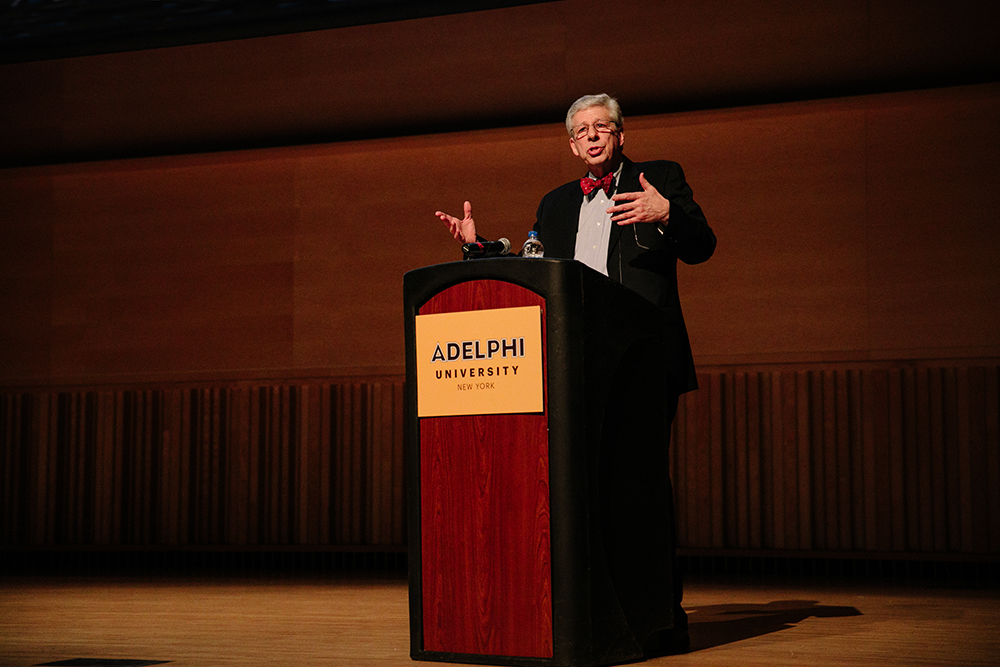At the Ruth S. Ammon School of Education's 37th annual Finkelstein Lecture in the Adelphi Performing Arts Center on October 17, 2018, Matt Jacobs, Nassau County regional staff director for the New York State United Teachers (NYSUT), expressed optimism about the future of unions despite the Supreme Court's controversial Mark Janus vs. AFSCME (American Federation of State, County and Municipal Employees) decision.

Addressing about 300 attendees at the Ruth S. Ammon School of Education’s 37th annual Finkelstein Lecture in the Adelphi Performing Arts Center on October 17, 2018, Matt Jacobs, Nassau County regional staff director for the New York State United Teachers (NYSUT), expressed optimism about the future of unions despite the Supreme Court’s controversial Mark Janus vs. AFSCME (American Federation of State, County and Municipal Employees) decision.
The lecture—titled “Mark Janus and Samuel Alito: Unwitting Architects of an American Union Renaissance?”—was sponsored by the Robert and Augusta P. Finkelstein Memorial Lecture Series.
Jacobs is a longtime unionist with NYSUT and with the National Education Association of New York before the two merged in 2006. He also taught social studies for more than 30 years.
That High Court decision in June 2018—overturning a previous ruling from 40 years ago—ruled that nonmembers can no longer be compelled to pay public sector union dues.
In his talk, Jacobs observed that Janus got all the pay raises and lower healthcare premiums his union (AFSCME) negotiated for all its members, despite his paying no union dues.
In the year before the Janus decision, NYSUT began “going to the members, explaining why unions are important to them and that collectively, we have strength. Individually, we don’t,” Jacobs said. That effort seems to have paid off so far, he said, noting that NYSUT, with 400,000 active members, saw just 318 dropped their memberships through October 12, 2018.
After the landmark ruling, a great deal of the press coverage painted a bleak picture for unions. A headline in The Atlantic, for instance, asked, “Is This the End of Public-Sector Unions in America?” A New York Times headline said, “Supreme Court Ruling Delivers a Sharp Blow to Labor Unions;” its story estimated that unions “could lose tens of millions of dollars.”
Huffington Post called the Supreme Court ruling “the biggest threat to organized labor in years… It could cost unions millions of members.” Forbes said that unions now “won’t be able to compel nonmembers to support their endeavors.” In its September 2018 “I’m a Teacher in America” cover story, Time said the ruling is one that “experts estimate could cost influential teachers’ unions money and clout.”
But Jacobs looked at the situation as a glass half full rather than half empty.
“I am optimistic [about unions’ future], but not blindly, foolishly optimistic,” he told the audience, mostly Ammon School students. “Unions were scared to death of this decision, and rightly so. Maybe we were more afraid than we should be.” He added, “This may be a blessing in disguise” for unions and public education.
“Unions had become too complacent,” he felt. “We got lazy, we stopped talking to [the members] … and treated unions as a business where members had little say.” Members, meanwhile, “started regarding unions as insurance policies” and union dues as “insurance premiums you pay to be protected.”
Strategies for Rebirth
Now unions will have to “work to keep them as members,” Jacobs said. “They’ve got to change what they’ve been doing the last 30 or 40 years.”
Jacobs suggested a number of ways in which unions might bring about a rebirth. Public sector unions must “take the lead” and “empower our members” to seek not 1 percent or 2 percent raises but “change fundamental power relationships,” he said. To do that, he said, unions must “organize members—and organize the communities we serve. And embrace collective action, even to the point of strikes.”
That’s what happened in Chicago in 2012, when teachers’ unions called a strike against a “tough” mayor and “brought the [largely minority] community into their negotiations and built a movement.”
While it’s likely other union members will drop out “down the road,” Jacobs maintained that “we have to keep doing what we started a year ago—educate our members and listen to them.”
Even so, the Janus decision is “not the last bad thing that will happen to unions,” Jacobs warned—especially now that Brett Kavanaugh’s confirmation as Supreme Court justice has tilted the High Court firmly into the conservative column. Jacobs mentioned, for example, that one future Supreme Court case will focus on whether payroll dues deductions are constitutional and that another may decide on tenure’s constitutionality.
Today, 34 percent of public sector employees belong to unions, he said—adding that’s the same percentage for private sector union members in the ’50s, when unions were “at their absolute zenith.” But now, only 6.3 percent of private sector workers are union members.
Jacobs pointed to research indicating that unions are looked upon more favorably than in recent years. One recent poll said that 60 percent of people “like unions,” he said, and that 76 percent of those under age 30 “think unions are good.” That last statistic is especially heartening, he said, since unions had feared that younger members who knew little about unions’ history might be first to quit. (Instead, 74 percent of those who quit NYSUT were 50 and older, he added.)
This fall, Nassau County has attracted “well over 1,000 new public school hires,” and “almost every one has joined [NYSUT),” Jacobs said.
For further information, please contact:
Todd Wilson
Strategic Communications Director
p – 516.237.8634
e – twilson@adelphi.edu